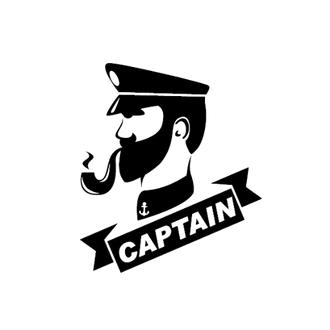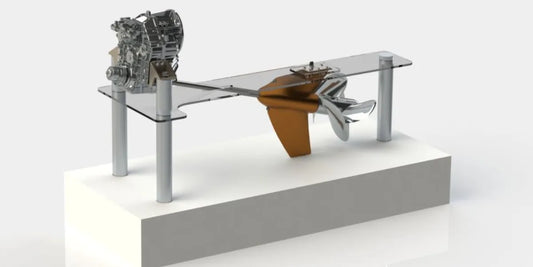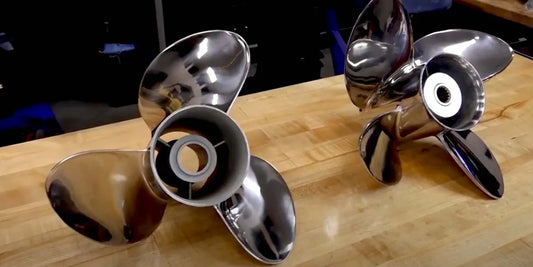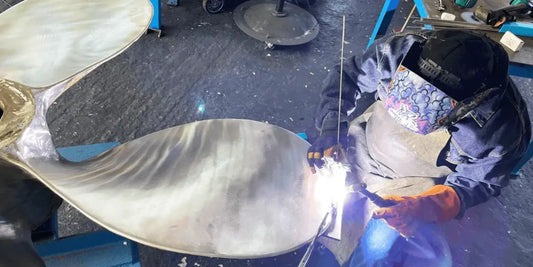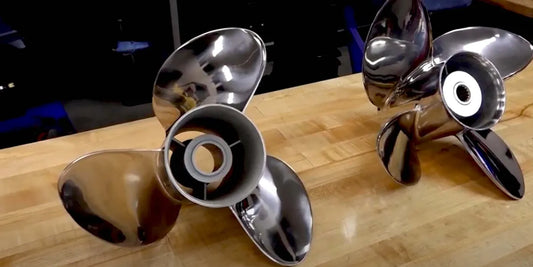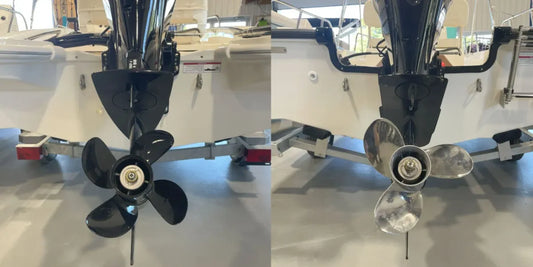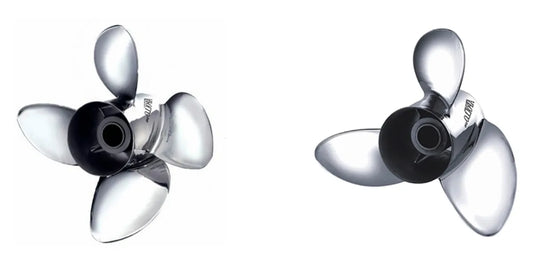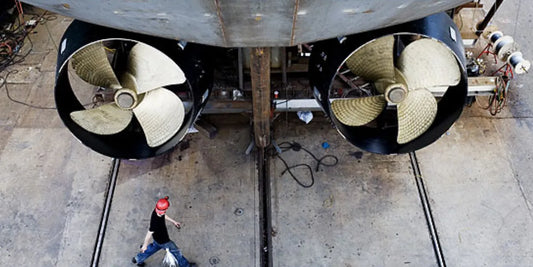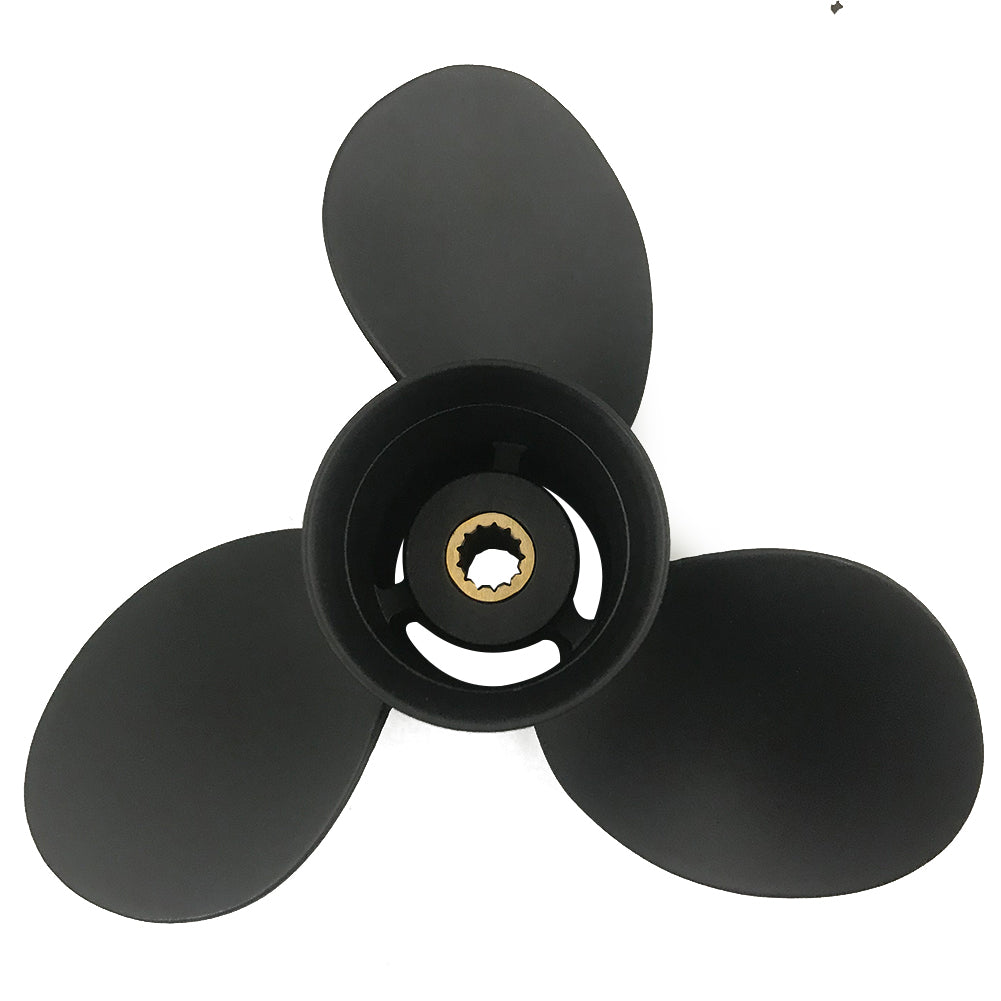Every vessel relies on propellers as the primary source of thrust; their performance and propulsive efficiency are entirely dependent on their design. Durable propellers, however, are not exempt from the passing of time; they can develop minor imperfections from collisions or more severe damage necessitating replacement. Being equipped with skillful knowledge regarding the finer aspects of propeller repairs can save you near endless hours spent with the vessel docked for repairs. This manual serves as a guide to address any issues concerning the repair process of the propeller, ranging from the most essential concerns to the complex actions of repairs and replacements. Whether you’re an experienced sailor or a beginner, this article will prepare you to execute the necessary steps for repair and ensure the vessel performs seamlessly.
What are the common signs of propeller damage?

How to identify propeller nicks and dents
Recognizing nicks and dents on your boat propeller is essential for achieving the best results with your vessel. Analyze each propeller blade for irregular features like chips, scraped lines, and bends toward the outer borders. Gradually glide your hand across the blade's edges to check for visible surface anomalies. Shine a flashlight to discover imperfections that might worsen with time.
Moreover, the symmetry of each blade can be assessed by measuring its angles and pitch with a protractor or a pitch gauge. Poor symmetry might suggest changes in performance, such as vibrations, differences in speed, and increased fuel burn. These indicators can hint at troubling propeller issues. Remember that propeller fatigue and damage will be reduced with proactive maintenance and regular checks.
Recognizing bent blades and their impact on boat performance
The angle of a boat's propeller would significantly affect the boat's speed. As previously stated, a deformed blade tip can affect the hydrodynamic equilibrium, which will cause excessive oscillation and thrust, which is not optimal. These changes may bring slower velocity, greater energy use, and possible stress on the engine or drive train because it is overworked. The first step in determining if blades are bent is looking at them. You can analyze the angle by measuring symmetry using gauges or protractors. Essential points for monitoring are:
Blade Pitch: Proper pitch measurements allow for good propulsion. The values should be consistent; otherwise, the blades may be deformed.
Vibration Frequency: Excessive oscillations may indicate problems caused by hydrodynamic bent blades.
Engine RPM: Changes in the index of engine revolution can show how inefficient the boat's processes are.
Fuel Consumption Rate: Fuel wastage increases when a propeller problem is present.
It is best to deal with bent blades early to prevent over-damage to critical boat components that keep the boat functioning.
When does propeller damage require immediate attention?
Bobbin blades that have sustained damage require immediate response under the following conditions:
Vibrational Damage: If the vibration amplitude is more significant than usual, it may mean that more than one blade is damaged or bent. A severe hydrodynamic imbalance could damage the propeller shaft or engine.
Engine RPM Changes: Changes in revolutions per minute that are unusual for the engine may indicate some disruption in propulsion efficiency.
Steep Rise in Fuel Usage: The unusually high Fuel usage suggests that the engine boat compensates for the efficiency reduced by propeller obstruction.
Visible Blade Deformation: Cracks, chips, or severe deformation of propeller blades indicate that they must be replaced or repaired to salvage performance.
Professional intervention for any of the conditions mentioned above will maximize performance and minimize the damage incurred to other boat systems.
How do I remove a damaged propeller from my boat?

Tools needed for propeller removal
This is the list of tools you will require for the removal of the incompetent propeller from your boat:
Propeller Wrench: This is a unique wrench explicitly made for the propeller nut so that neither the wrench nor the nut is destroyed during the fitting.
Socket Wrench Or Adjustable Wrench: This can serve as a propeller tool, but only if a propeller wrench is unavailable; caution is advised to ensure the nut is not stripped.
Grease or Penetrating Oil: This is used for lubricating stubborn and rusted bolts or nuts.
Needle Nose Pliers or Snap Ring Pliers(If applicable): used for a range of cotter and retaining pins that secure the propeller.
Replacement Parts (If Needed): These parts include new propeller nuts, cotter pins, and spacers to replace worn or damaged old parts.
Remember to check with your boat's manual for the appropriate size of the propeller nut, your model's removal process, and the distance it requires to be affixed. It is equally essential to be meticulous to ensure that the drive shaft and its aided components are not destroyed in the process.
A step-by-step guide to removing a propeller from the prop shaft
Assemble Tools: Get all items ready alongside pliers, a socket wrench set, and any replacement parts you might need. Check your boat’s user manual to determine the propeller nut socket’s dimensions and torque specifications to ensure you have everything in order.
Safety Measures: Remember that turning off the engine and disconnecting the battery should always be the first step to prevent accidents. Ensure the boat is immobilized on the trailer or lifted out of the water to access the propeller safely and securely.
Take off the Propeller Nut: Use a socket wrench to loosen the propeller nut. If a cotter pin socket is present, remove it first, then loosen the nut. This will make it easier to remove the propeller.
Detach Propeller: Attempt to allow the propeller to slide off the shaft, but do not pull too hard to minimize damage to the drive shaft. If the propeller is stuck, wiggle it back and forth until you feel it loosen up.
Check Components: Ideally, all of these parts – drive shaft, spacers, propeller, and thrust washer – should be free from any surface damage signs like corrosion or wear. If you spot any, don’t hesitate to get your hands on new parts to replace propeller nuts, cotter pins, and other spacers.
Use a cloth and clean the debris and grease from the shaft. Ensure it is smooth to the touch before putting the propeller back on to prevent damage.
Look up the manual for the exact torque specifications: Check the manual for the correct values when reinstalling a new propeller. Adequate torque eliminates the possibility of many issues like overtightening or loose parts.
Completing these steps will ensure you can safely and effectively remove a propeller while minimizing damage to your boat’s propulsion system.
Safety precautions when handling boat propellers
Use Safety Equipment: Always wear gloves to protect your hands from the blades' sharp edges and goggles to protect your eyes from flying debris or oil splashes.
Confirm the Engine is Shut Off: Ensure the engine is off. The ignition key is removed before attempting to operate the propeller to avoid opportunities for starting up the engine.
Secure the Boat: Check that the boat is anchored or resting on a solid base that will not budge; this will reduce the chances of movement while working on the propeller.
Propeller Accuracy: Avoid hitting or scraping any other part of the propeller. The blades can be very sharp and may trim your fingers if you are not careful.
Confirm Tools Available: Make sure the tools (e.g., a propeller-specific wrench) to apply engagement or disengagement to the nut that secures the propeller are available. Follow all torque settings as described in the manual, which generally varies from 55 to 'to complete this field consult' value matches.
Check the Working Area: Always assume that objects not meant to be in that area are cluttered and verify that before removing or placing them, as they may present dangers.
Recycle Damaged Props in an Eco-Friendly Manner: If in contact with damaged propellers, ensure that the posted mobility shackles to Germany are regulated so that no NFU demi saranijeable spoilers vote.
Following these precautions and consulting the relevant technical manuals, you can safely manage boat propellers while safeguarding yourself and the equipment.
What are the differences between aluminum and stainless steel props?

Pros and cons of aluminum propellers
Pros:
Affordability: While both aluminum and stainless steel propellers have their places, aluminum’s price is more aligned with that of casual and recreational boaters looking to save some money as they enjoy their time on the water.
Lightweight: Using aluminum means less weight which means less hassle of dealing with a heavy propeller while installing or replacing it.
Ease of Repair: Repairing small damages done to aluminum propellers is super economical, which makes them a favorable option for regular boaters.
Cons:
Lower Durability: The overall structural durability of aluminum propellers having a severe impact and abrasion resistance is significantly weaker when compared to steel, which means… bending and chipping is very likely fast.
Limited Performance: Rush aluminum affects assistive performance because propellers flex and bend at higher speeds and high horsepower operations; this flexing is pretty awful for heavy aluminum.
Shorter Lifespan: Forgetting any pretense around needing excessive loads and using aluminum propellers will surely lead to dire consequences in the toughest conditions and more extended periods.
Technical Parameters:
Material Strength: Aluminum's tensile strength is around 15 –20 ksi, while stainless steel's is 70-90 ksi. This difference affects overall wear and tear capabilities.
Weight: Aluminum is a significantly lighter material at approximately 2. 7 g/cm³ compared to stainless Steel, which weighs 7.8 g/cm³ but is less dense.
Efficiency: Under ideal conditions where horsepower is above 150, the efficiency of functioning in combination with aluminum propellers is a tough 2 but able to achieve passive defects due to slab flex.
In the long run, aluminum propellers offer little to no practicality in high load conditions, making them ideal for casual boaters looking for budget-friendly lightweight options.
Advantages of stainless steel propellers
Durability: Compared to aluminum propellers, stainless steel ones offer greater durability, being less susceptible to impacts, corrosion, and wear. Thus, they are the best choice over long periods of use in salt water and high-stress environments.
Performance Efficiency: Stainless steel propellers, because of their rigidity, have almost no blade flex, which augments performance efficiency. Thus, they are ideal for high horsepower engines (greater than 150HP) or faster boats that must be powered consistently.
Thinner Blade Design: Stainless steel can create thinner, more accurately crafted blades, which improves hydrodynamic performance and enables faster acceleration and higher top speeds.
Longevity: Stainless steel propellers are more cost-efficient over time because they are less prone to damage due to fatigue. Despite the higher upfront cost, they offer higher long-term value.
These advantages make stainless steel propellers the most effective option for boaters looking for a high-performance, durable option, regardless of the higher investment.
How propeller material affects repair options
The material used for propeller repairs is heavily influenced by factors regarding strength, flexural rigidity, and ease of machinability. Although stainless steel propellers might be impact-resistant, the repairs are laborious and expensive because the material is too hard to work with. Dents, cracks, and bends on these stainless steel propellers usually require specialized tools and techniques. On the other hand, aluminum propellers may be less durable, but repairs are more straightforward because the softer, more malleable material is easier to work with.
Material Hardness: Stainless steel bling has a Brinell hardness of 130-220 (depending on grade), while aluminum has a meager 30-70. Strengthening stainless steel makes it more challenging to work with during repairs.
Ductility/Flexibility: Stainless steel, on the other hand, requires more patience due to its extreme flexibility, whereas aluminum can be reshaped with far greater ease.
Repair Costs: Due to the equipment and labor needed, repairs on stainless steel propellers cost two to three times more than those on aluminum propellers.
At the end of the day, while stainless steel propellers have better performance and life span, their repairs are more suited for experienced professionals who lean the scale for easier maintenance towards aluminum.
How do I choose the correct replacement propeller for my boat?

Understanding propeller size and pitch
Both the propeller's size and pitch are essential references regarding the replacement propeller for your boat. The size of the propeller is the area of the circle whose circumference is formed by the edges of the propeller blades. The size selected must not exceed what is suitable for the power produced by the engine and design of the boat. Generally, larger propellers provide a more enormous thrust, which is appropriate for larger boats, while smaller props are efficient for lighter and faster vessels.
Pitch is defined as the distance traveled along the propeller shaft by a propeller in one complete revolution, provided there is no backward slip. A lower-pitch prop is more powerful, accelerates well, and is best suited for towing or low-speed movement, while high-end pitch props will give better top-speed performance but will lack acceleration.
Diameter: The propeller's diameter must be appropriate for your engine and boat to function efficiently.
Pitch: A desirable pitch should match the use of your boat; for example, sports like towing might require a lower pitch of 17 inches or less, while speed-predominant tasks might require 21 inches or more.
Engine RPM Range: Make sure that the propeller selected ensures the engine can operate within its preferred range. Above or below this range is often not utilizing or over-utilising the engine. Usually, this range is detailed in your engine manual.
These blades have varying configurations. Most propellers are three-bladed, which provides good performance, but four-bladed propellers are better suited for slower speeds and have less vibration.
Considering all these factors simultaneously will allow you to choose a propeller for your boat that increases its efficiency and performance while meeting your designated usage requirements.
Factors to consider when selecting a new prop
When choosing a new propeller, I consider several factors to ensure it meets my boat's performance level. First, I try to understand its intended use for water sports, fishing, or cruising because this directly correlates with the pitch and diameter I am supposed to select. For example, propellers that need higher acceleration in shorter periods may require a low-pitch prop to reach higher RPMs.
Secondly, I focus on the engine and its RPM range. I check if the propeller enables my engine to operate within the manufacturer's suggested range since that prevents the engine from straining and working optimally. For example, a propeller with a too-high pitch would lead to lower-than-optimal RPMs and potentially overvoltage the engine.
Next, I check the pitch, which affects control and performance. A propeller with three blades is generally sufficient for most uses, but I switch to a four-blade propeller when I need the added power and smooth speed operation.
One last factor I consider is materials, such as stainless steel for performance and durability, or aluminum, which is more affordable and valuable if I encounter rougher conditions. All the decisions come back to these propeller parameters to ensure my boat performs better for its designated purpose.
Where to buy quality replacement propellers
When looking for quality replacement propellers, my first stop is always a reputable online or local marine supply store. Regional shops usually let me talk to specialists in person, guaranteeing that the propellers match my boat's required engine and performance specifications. Alternatively, online suppliers have a broader selection, making comparing the different brands and materials offered simpler.
While purchasing, I ensure the propeller corresponds to the technical details directly related to my boat. For example, I check the pitch against my engine's recommended rpm range to ensure there is no possibility of overloading or underworking the propeller. I also factor the blade count into my specific usage, whether speed or stability in rough waters, three blades or four, respectively. The material also matters; I choose stainless steel for strength and durability, while aluminum is preferred for hassle-free budget consideration. These factors make sure that the replacement propeller performs well.
What maintenance tips can help prevent propeller damage?

Regular inspection and cleaning of boat propellers
Boats operate efficiently when their propellors are inspected and cleaned thoroughly regularly. Visual inspections should be conducted, followed by assessments of any cracks or bends, as these may lead to propeller rod vibrations. Additionally, barnacles and seaweed should be checked for, as they can increase drag and limit speed. Enclosed props should be scratched off with a soft-bristle brush and mild soap for optimal cleansing.
Blade alignment: Damaged blades result in improper rotational friction; thus, blades should be replaced and/or repaired for efficient movement.
Hub integrity: Damage of hubs leads to power loss; hence, they must be fully functional and undamaged.
Shaft connection: The propeller must be bolted firmly to the shaft to keep it from spinning freely.
Surface condition: Smooth and shiny blades capture fuel more efficiently and improve hydrodynamics.
Following the stated pointers will prolong the effectiveness of your propellor and boost your overall boating efficiency.
Proper storage techniques to protect propeller blades
I always protect the propeller when storing my boat, as a more damaged propeller will make a ship perform worse. First, I scrub the propeller with a soft brush to remove obstructions, seawater, or algae. Doing this prevents corrosion and a build-up for a long time. Second, I spray the propeller with anti-corrosion spray after cleaning it. This is particularly useful when using stainless steel propellers as it helps against rust. I also wrap my cloth propeller cover around the trained blades to prevent unattractive scratches or nicks if I plan to store the boat outside. Storing the boat in a dry, controlled environment isn’t necessary but is helpful as it reduces exposure to harsh elements.
Correct propeller storage and coverage lead to the preservation of significant technical features such as blade damage, pitch, and integrity. Aid prevention leads to adverse effects such as increased vibrations and thrust. Moreover, wrapping the propeller with aluminum or stainless steel guarantees better preservation during subsequent usage.
The importance of carrying a spare prop
It is essential to carry a spare propeller handy onboard to maintain seamless functionality aboard the vessel. Hitting submerged debris or mechanical failures can happen anytime and damage the propeller, leaving you lost nowhere. Possessing a spare propeller eliminates extensive downtime and reduces reliance on costly tow services.
In selecting a spare propeller, there are principle parameters that need to be satisfied to achieve the same level of result:
Pitch - The backup propeller should have similar propeller thrust and efficiency, so the pitch has to be the same.
Diameter - It should match the engine's power and the hull's requirements for steadfast movement.
Blade Count - The number of blades should be identical to the original propeller to retain throttle responsivness high-speed handling.
Material – Pick constructors from the same material, such as aluminum or stainless steel, to guarantee versatility and durability.
These parameters guarantee that the thrust output responsive speed, fuel efficiency while operating the vessel,, and control over the vessel dynamics are not negatively distorted.
Frequently Asked Questions (FAQs)
Q: What are the most common reasons for marine propeller repairs?
A: Some of the primary reasons for marine propeller repair are collision with submarine obstructions, corrosion, cavitation damage, and general depreciation. Even the most minor damage to a propeller can cause a drop in performance and efficiency, making its repair indispensable to boat owners.
Q: Should I fix the prop myself, or is it better to contact a professional?
A: While most small DIY repairs can be done with little knowledge, it is best to enlist the help of professionals in the case of more complicated repairs. Professionals will always have the tools necessary alongside a deep understanding of what needs to be done to the prop so that it is in proper balance and alignment to perform optimally without getting into expensive repairs later on.
Q: How does the prop material affect repair and maintenance?
A: Different materials will always make a difference in how a prop is repaired and its durability. Aluminum props, for instance, get easily damaged but come with lower repair costs. It is the opposite of stainless steel since it is more expensive to repair but more durable. Composite props are an example of a material that can be damaged and will require the prop to be replaced altogether.
Q: What goes on in outboard prop repair?
A: Outboard prop repair usually starts with assessing the damage. Then comes the straightening of bent blades before going onto the more difficult parts, like welding the cracks or chips discovered throughout. The prop shaft and seal must be functioning optimally at the same time. Outboard prop repair services can complete the required repairs using specialized equipment, enabling them to meet the requirements to make the propeller fully functional.
Q: How regularly do I need to check the propeller of my boat?
A: Preventing damage to a boat requires regular checks and inspections of the propeller. Inspect visually the propeller before attempting to use the ship and inspect thoroughly at least once a season. Check the blade edges for signs of bending or dings, scratching, and if the propeller is attached securely. If dealt with early on, expenses on repairs can be avoided.
Q: Would one consider using an old prop as a substitute?
A: Anyone can buy an old used prop, but purchasing one when out of options is recommended. Used propellers impact a boat's performance due to having hidden damage or wear that most people can't notice. It is highly recommended that such props be left to the hands of a professional or be thoroughly inspected before attempting to use them. New props would be a much safer, economical choice for long-term reliability.
Q: How do I select the propeller suitable for my boat’s size?
A: Performance of the boat can be remarkably affected by the type of propeller used, therefore make sure to consult the boat’s manual while considering the type of boat, engine horsepower, hull design, and its intended use. Some people buy Michigan Wheel because they have sizing charts that customers like them offer. However, they should speak to a marine professional to ensure the person with specific needs gets the correct sizing.
Q: What actions can I take to minimize propeller repairs?
A: These repairs can be minimized by not going into shallow waters, using a prop guard in dirty places, deflating the engine trim, keeping the prop clean, and putting antifouling paint if needed. All these things will reduce the chances of damage while extending the propeller's life. Remember that caring for the propeller greatly aids boat ownership by minimizing repair costs.
